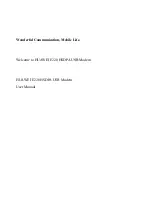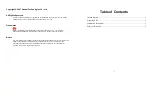
Configure network interfaces
Configure ISDN interfaces
Digi TransPort WR Routers User Guide
249
Answering ISDN calls
Digi routers can answer incoming B-channel ISDN calls with three main protocols: rate adaption
protocols, LAPB, and PPP. Usually several instances of these protocols exist. This section explains
how answering priorities work for the different protocols.
Protocol entities
The following protocol instances are capable of answering an incoming ISDN call:
Adapt
Adapt instances provide rate adaptation protocols such as V.120 or V.110.
LAPB
LAPB instances allow the router to answer incoming X.25 calls over ISDN. These instances can
optionally connect the caller to a synchronous serial port, an asynchronous serial port bound to a
PAD, or switch the call to another interface.
PPP
IP data tunneled over PPP instances allows remote access to the router’s IP-based management
features and also facilitates onward IP routing through any of the router’s IP enabled interfaces.
The router automatically answers an incoming ISDN call if any of the following statements are true,
subject to the entity’s
MSN
,
Calling Number
and
Sub-address
parameters being set to their default
values:
▪
An Adapt instance is bound to an asynchronous serial port (ASY) and the answer ring count (S0)
for that serial port is set to 1
▪
A LAPB instance has its answering parameter set to On
▪
A PPP instance has its answering parameter set to On
If more than one of these protocols are configured to auto answer then the priority is as follows:
Adapt instances (normally V.120) will take priority over LAPB, which will take priority over PPP. If an
Adapt instance is bound to an asynchronous serial port (ASY port) but the answer ring count (ATS0)
is not set to 1 for that same serial port then Adapt entity will not answer automatically. If any other
protocol entities (such as LAPB, PPP or another Adapt instance) are configured to answer then one
of these protocol entities will answer the call. If no other protocol entities are configured to answer
then a repeating RING message will be sent out of the serial port and the RS232 ring indicator
control will be activated. If a terminal attached to the serial port sends ATA followed by carriage
return then the ISDN call will be answered by the Adapt entity and any incoming data will be
channeled out of the serial port and vice-versa.
Summary of Contents for TransPort WR11
Page 1: ...User Guide Digi TransPort WR Routers ...
Page 650: ...Configure system settings NTP parameters Digi TransPort WR Routers User Guide 650 ...
Page 661: ...Configure system settings General system parameters Digi TransPort WR Routers User Guide 661 ...
Page 662: ...Configure system settings General system parameters Digi TransPort WR Routers User Guide 662 ...
Page 663: ...Configure system settings General system parameters Digi TransPort WR Routers User Guide 663 ...
Page 682: ...Configure Remote Management SNMP parameters Digi TransPort WR Routers User Guide 679 ...
Page 683: ...Configure Remote Management SNMP parameters Digi TransPort WR Routers User Guide 680 ...
Page 813: ...Manage networks and connections Top Talkers Digi TransPort WR Routers User Guide 808 ...
Page 814: ...Manage networks and connections Top Talkers Digi TransPort WR Routers User Guide 809 ...
Page 815: ...Manage networks and connections Top Talkers Digi TransPort WR Routers User Guide 810 ...
Page 816: ...Manage networks and connections Top Talkers Digi TransPort WR Routers User Guide 811 ...
Page 817: ...Manage networks and connections Top Talkers Digi TransPort WR Routers User Guide 812 ...
Page 818: ...Manage networks and connections Top Talkers Digi TransPort WR Routers User Guide 813 ...
Page 855: ...Device administration Reboot the router Digi TransPort WR Routers User Guide 844 ...
















































